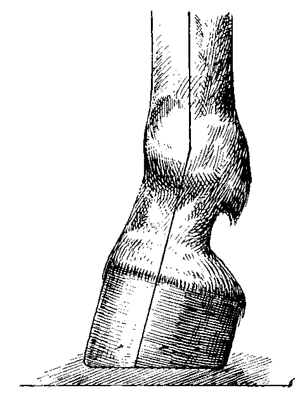Club-foot
 Under this name we indicate all cases in which the horn of the wall become straightened from above to below. It will, therefore, include all conformations varying from the so-called 'upright hoof,' in which the toe forms an angle of more than 60 degrees with the ground, to the badly 'clubbed' foot, in which the horn at the toe forms a right angle with the ground, or is even directed obliquely backwards and downwards, so that the coronary margin overhangs the solar edge of the wall.
Under this name we indicate all cases in which the horn of the wall become straightened from above to below. It will, therefore, include all conformations varying from the so-called 'upright hoof,' in which the toe forms an angle of more than 60 degrees with the ground, to the badly 'clubbed' foot, in which the horn at the toe forms a right angle with the ground, or is even directed obliquely backwards and downwards, so that the coronary margin overhangs the solar edge of the wall.Symptoms of club-foot
Even in its least pronounced form the condition is apparent at a glance, the alteration in the angle formed by the hoof with the ground striking the eye at once, and the heels, as compared with the toe, appearing much too high. When the condition is slight, the wall of the toe is about twice as high as that of the heels, while in the most marked form the toe and the heels may in height be nearly equal (see the picture on the right).
When congenital, but little interference with the action is noticed. Such animals, by reason of their 'stiltiness,' are unfit for the saddle, but at ordinary work will perform their duties equally well with the animal of normal-shaped feet. When acquired as the result of overwork, of contracted tendons, or other causes, however, the gait becomes stumbling and uncertain. The body-weight is transferred from the heels to the anterior parts of the foot, and the shoe shows undue signs of wear at the toe.
Causes of club-foot
Upright hoof is undoubtedly hereditary, and is even seen as a natural conformation in the feet of asses and mules. When hereditary in the horse, however, it is certainly a defect, and is associated commonly with an upright limb, and a short, upright pastern (see the picture on the right).